Discover the most popular Mexican food with a guide perfect for LGBTQ+ travelers seeking authentic culinary experiences! At gaymexico.net, we know that exploring a culture’s cuisine is a fantastic way to connect with its people and traditions. Get ready to savor the flavors of Mexico and uncover hidden culinary gems with recommendations tailored for the LGBTQ+ community. Embrace Mexico’s rich food scene, find your new favorite dish, and create unforgettable memories. Let’s dive in and find the flavors that call to you, including tacos, enchiladas, and mole.
1. Understanding Mexican Cuisine: A Journey Through Flavors
Mexican cuisine is more than just tacos and burritos; it’s a diverse tapestry woven from centuries of history, indigenous traditions, and culinary innovation. Understanding the core elements of Mexican food will enhance your appreciation and enjoyment of every meal. The base of most dishes, like the culture itself, is corn.
1.1. The Cornerstone: Corn, Beans, and Chiles
Corn, beans, and chiles are the holy trinity of Mexican cuisine. Corn, in the form of tortillas, tamales, and masa, is a staple found in countless dishes. Beans provide essential protein and fiber, while chiles add depth, heat, and complexity to sauces and stews.
- Corn (Maíz): Used in tortillas, tamales, atole, and countless other dishes.
- Beans (Frijoles): A primary source of protein, often served as a side or used in fillings.
- Chiles: Ranging from mild to intensely spicy, chiles are essential for flavor and heat.
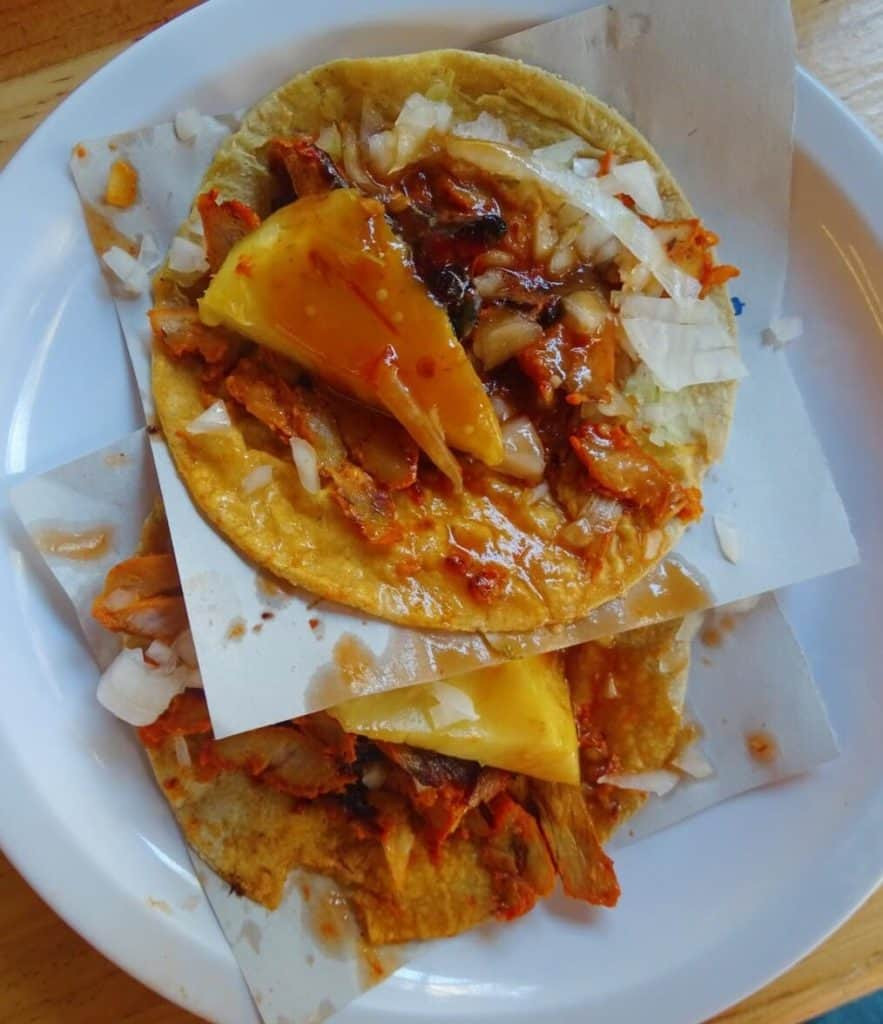 Corn tortillas, a staple of Mexican cuisine, showcasing the importance of corn.
Corn tortillas, a staple of Mexican cuisine, showcasing the importance of corn.
1.2. Regional Variations: A Culinary Map of Mexico
Mexico’s vast geography and diverse cultures have given rise to distinct regional cuisines, each with its own unique ingredients and culinary traditions.
- Oaxaca: Known for its complex mole sauces, tlayudas (large, crispy tortillas), and mezcal.
- Yucatán: Famous for cochinita pibil (slow-roasted pork), sopa de lima (lime soup), and habanero chiles.
- Puebla: Celebrated for its chile en nogada (stuffed poblano pepper with walnut sauce) and mole poblano.
- Veracruz: Renowned for its seafood dishes, such as pescado a la Veracruzana (fish in tomato sauce with olives and capers).
- Mexico City: A melting pot of flavors, offering everything from street tacos to haute cuisine.
1.3. Pre-Hispanic Influences: Ancient Culinary Traditions
Many of Mexico’s most beloved dishes have roots in pre-Hispanic cultures, with ingredients and techniques passed down through generations.
- Tamales: Steamed corn dough filled with meat, vegetables, or sweets, dating back to ancient Mesoamerica.
- Mole: A complex sauce made from chiles, spices, and sometimes chocolate, with origins in pre-Columbian cuisine.
- Pozole: A hearty soup made from hominy (dried corn kernels), meat, and chiles, traditionally prepared for ceremonial occasions.
1.4. Spanish Influences: A Culinary Fusion
The arrival of the Spanish in the 16th century brought new ingredients and culinary techniques to Mexico, resulting in a unique fusion of flavors.
- Dairy Products: Cheese, cream, and milk-based desserts were introduced by the Spanish and have become integral to Mexican cuisine.
- Pork and Beef: These meats were brought by the Spanish and are now widely used in dishes like carnitas (slow-cooked pork) and carne asada (grilled beef).
- Wheat: Introduced by the Spanish, wheat flour is used to make tortillas in some regions, as well as bread and pastries.
1.5. A Foodie Destination: A Guide for LGBTQ+ Travelers
Mexico is an increasingly inclusive destination with vibrant cities, and stunning beaches. The country’s culinary scene caters to a variety of tastes. From street food stands to high-end restaurants, the choices are endless.
- Puerto Vallarta: A favorite among LGBTQ+ travelers, offers a mix of traditional and contemporary Mexican cuisine. You can enjoy seafood on the beach or dine in romantic, candle-lit restaurants.
- Mexico City: A global culinary hub, boasting everything from historic cantinas to innovative fusion restaurants. The Roma and Condesa neighborhoods are particularly known for their trendy eateries and cafes.
- Guadalajara: Home to tequila and mariachi music, Guadalajara also has a rich culinary heritage. Try birria (a spicy goat stew) and tortas ahogadas (sandwiches drowned in sauce) for an authentic taste of the city.
2. Tacos: Mexico’s Most Iconic Dish
Tacos are arguably Mexico’s most famous culinary export, enjoyed around the world in countless variations. However, the true essence of a taco lies in its simplicity and the quality of its ingredients.
2.1. The Anatomy of a Taco: Tortilla, Filling, and Salsa
A taco consists of three essential components: a tortilla, a filling, and salsa. The tortilla, typically made from corn, serves as the foundation, while the filling provides the main flavor and texture. Salsa adds a final touch of heat and complexity.
- Tortillas: Corn tortillas are the most traditional, but wheat tortillas are also used in some regions.
- Fillings: Options range from grilled meats and seafood to vegetables and beans.
- Salsas: Vary in heat level and ingredients, from mild pico de gallo to fiery habanero salsa.
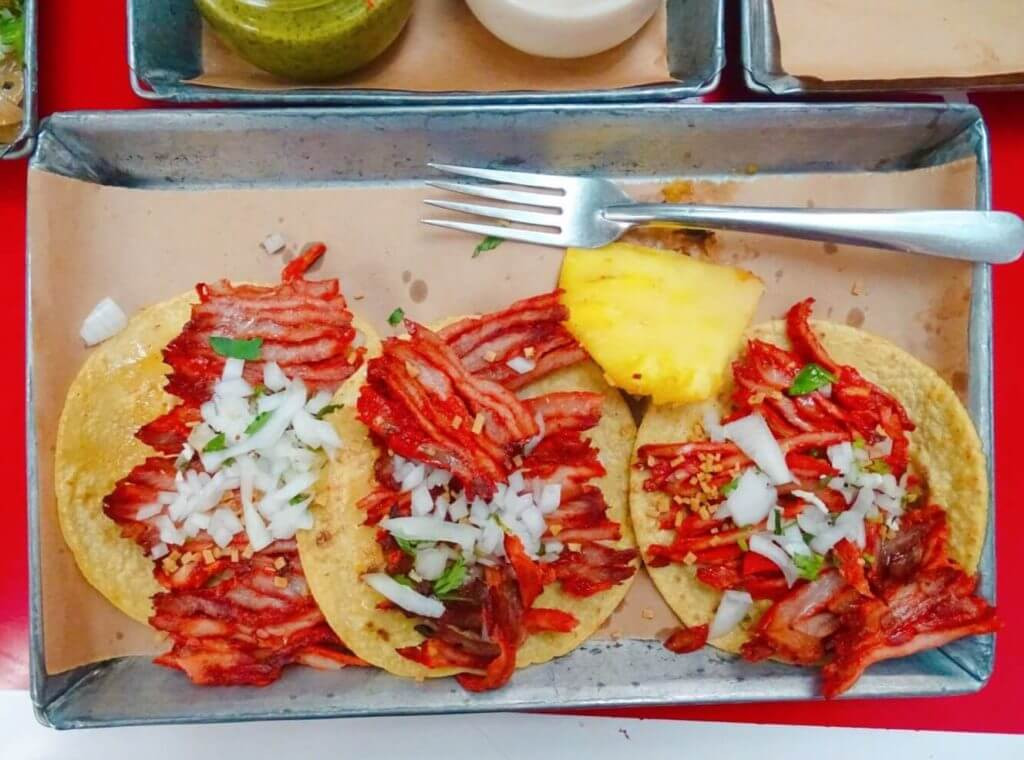 Assortment of taco fillings, showcasing the versatility of Mexican cuisine.
Assortment of taco fillings, showcasing the versatility of Mexican cuisine.
2.2. Popular Taco Varieties: A Culinary Adventure
With so many taco fillings to choose from, there’s a taco for every palate. Here are some of the most popular varieties:
- Tacos al Pastor: Marinated pork cooked on a vertical spit, served with pineapple, onions, and cilantro.
- Carnitas Tacos: Slow-cooked pork that is shredded and served with salsa and pickled onions.
- Carne Asada Tacos: Grilled beef that is seasoned with spices and served with guacamole and pico de gallo.
- Fish Tacos: Battered or grilled fish served with coleslaw, lime, and chipotle mayo.
- Vegetarian Tacos: Options include black beans, grilled vegetables, and nopales (cactus).
2.3. Where to Find the Best Tacos: A Local’s Guide
Whether you’re in Mexico City, Puerto Vallarta, or Guadalajara, you’re never far from a great taco stand. Ask locals for their recommendations or explore the following neighborhoods:
- Mexico City: Roma, Condesa, and Coyoacán are known for their diverse taco offerings.
- Puerto Vallarta: The Malecon (boardwalk) and Zona Romantica are home to many excellent taco restaurants.
- Guadalajara: Tlaquepaque and Chapultepec offer a mix of traditional and modern taco experiences.
2.4. Taco Culture: More Than Just a Meal
In Mexico, tacos are more than just a meal; they’re a cultural institution. Tacos are enjoyed for breakfast, lunch, and dinner, and are often eaten standing up at street-side stands. Sharing tacos with friends and family is a common way to socialize and celebrate.
- Taco Stands: A ubiquitous part of Mexican street life, offering a quick and affordable meal.
- Taco Nights: A popular social event, where friends and family gather to make and eat tacos together.
- Taco Festivals: Celebrations of all things taco, featuring live music, food vendors, and taco-eating contests.
3. Mole: A Symphony of Flavors
Mole is one of Mexico’s most complex and intriguing dishes, a sauce made from a blend of chiles, spices, nuts, seeds, and sometimes chocolate. The process of making mole can take hours or even days, resulting in a rich and flavorful sauce that is truly unique.
3.1. The History of Mole: From Ancient Roots to Modern Cuisine
Mole has its roots in pre-Hispanic cuisine, with ancient versions made from chiles, seeds, and spices. The arrival of the Spanish brought new ingredients like nuts, chocolate, and cinnamon, resulting in the complex and diverse mole sauces we know today.
- Pre-Hispanic Origins: Ancient versions of mole were used in ceremonial dishes and were considered a delicacy.
- Spanish Influence: The Spanish introduced new ingredients that transformed mole into a more complex and flavorful sauce.
- Regional Variations: Each region of Mexico has its own unique mole recipe, reflecting local ingredients and culinary traditions.
 A bowl of mole poblano, showcasing the rich color and complex ingredients.
A bowl of mole poblano, showcasing the rich color and complex ingredients.
3.2. Key Ingredients: A Culinary Alchemy
Mole is made from a wide range of ingredients, each contributing to its unique flavor profile. Some of the most common ingredients include:
- Chiles: Ancho, pasilla, and mulato chiles are commonly used in mole sauces.
- Spices: Cinnamon, cloves, cumin, and coriander add warmth and complexity.
- Nuts and Seeds: Almonds, peanuts, sesame seeds, and pumpkin seeds provide richness and texture.
- Chocolate: Used in some mole recipes, adding depth and a subtle sweetness.
- Fruits: Raisins, plantains, and apples are sometimes added to mole for a touch of sweetness and acidity.
3.3. Mole Poblano: The Queen of Moles
Mole poblano, originating from the city of Puebla, is perhaps the most famous mole in Mexico. Made from over 30 ingredients, including chiles, spices, nuts, chocolate, and fruits, mole poblano is a complex and flavorful sauce that is typically served with chicken or turkey.
- Ingredients: Ancho, pasilla, and mulato chiles, almonds, peanuts, chocolate, cinnamon, cloves, and anise.
- Preparation: The ingredients are ground into a paste, then simmered with broth and spices for hours.
- Serving: Typically served with chicken or turkey, garnished with sesame seeds and onions.
3.4. Exploring Different Types of Mole: A Culinary Spectrum
While mole poblano is the most well-known, there are many other types of mole to discover, each with its own unique flavor profile:
- Mole Negro: A dark and intense mole made with black chiles and chocolate, typically found in Oaxaca.
- Mole Rojo: A red mole made with red chiles and spices, often served with pork or chicken.
- Mole Verde: A green mole made with green chiles, herbs, and pumpkin seeds, typically served with fish or vegetables.
- Mole Amarillo: A yellow mole made with yellow chiles and spices, often served with chicken or pork.
3.5. Where to Try Mole: A Mole Pilgrimage
To experience the true essence of mole, visit one of the following destinations:
- Puebla: The birthplace of mole poblano, offering numerous restaurants specializing in this iconic dish.
- Oaxaca: Known for its diverse mole offerings, including mole negro, rojo, and verde.
- Mexico City: Many restaurants in Mexico City serve mole, both traditional and modern interpretations.
4. Tamales: A Taste of Ancient Mexico
Tamales are a traditional Mexican dish made from masa (corn dough) filled with meat, vegetables, or sweets, wrapped in corn husks or banana leaves, and steamed. Dating back to ancient Mesoamerica, tamales are a staple of Mexican cuisine and are enjoyed throughout the country.
4.1. The History of Tamales: From Ancient Rituals to Everyday Meals
Tamales have been a part of Mexican cuisine for thousands of years, with evidence suggesting they were consumed as early as 7000 BC. In ancient Mesoamerica, tamales were used in religious ceremonies and were considered a sacred food.
- Ancient Origins: Tamales were a staple of the Mayan and Aztec diets and were used in religious rituals.
- Colonial Era: The Spanish introduced new ingredients like pork and cheese, which were incorporated into tamale recipes.
- Modern Tamales: Today, tamales are enjoyed as an everyday meal and are often served during holidays and special occasions.
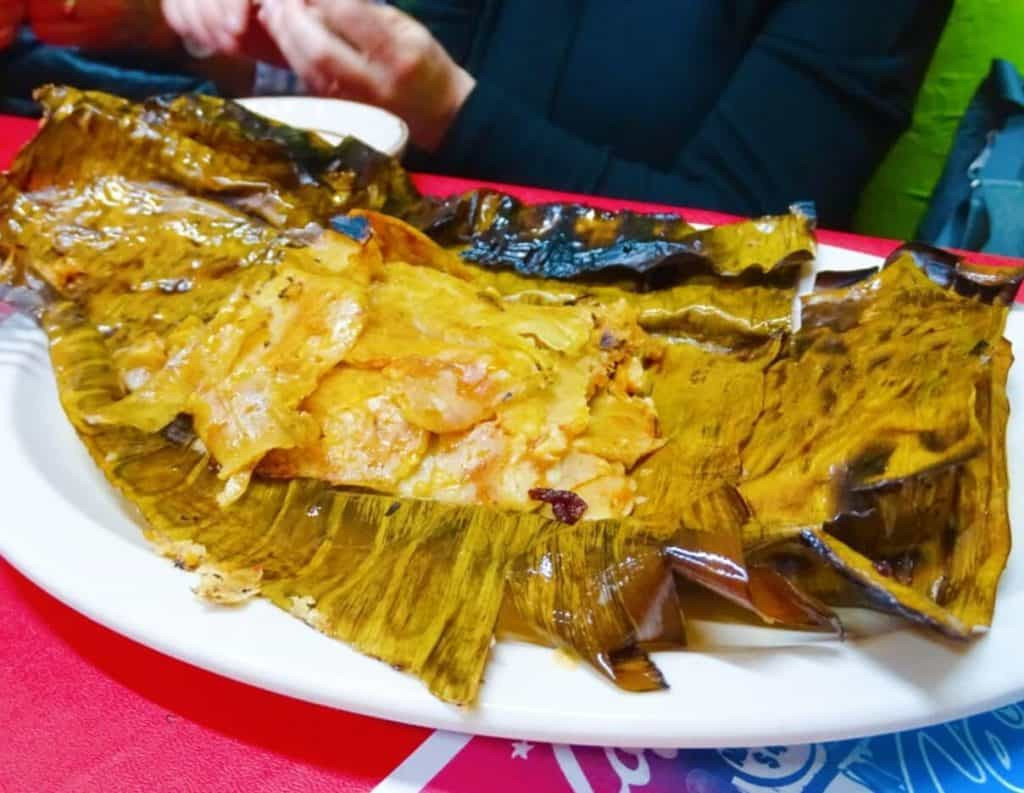 An assortment of tamales, showcasing the variety of fillings and wrappers.
An assortment of tamales, showcasing the variety of fillings and wrappers.
4.2. Key Ingredients: The Building Blocks of a Tamale
The key ingredients in a tamale are masa, filling, and wrapper.
- Masa: Made from ground corn that has been treated with lime, masa is the base of the tamale.
- Filling: Options range from meat and vegetables to cheese and sweets.
- Wrapper: Corn husks or banana leaves are used to wrap the tamale, adding flavor and moisture during steaming.
4.3. Popular Tamale Varieties: A Culinary Spectrum
With so many fillings and flavors to choose from, there’s a tamale for every palate. Here are some of the most popular varieties:
- Chicken Tamales: Filled with shredded chicken and salsa verde or roja.
- Pork Tamales: Filled with slow-cooked pork and chili sauce.
- Vegetarian Tamales: Options include cheese, beans, vegetables, and huitlacoche (corn fungus).
- Sweet Tamales: Filled with fruits, cinnamon, and sugar.
4.4. How Tamales Are Made: A Labor of Love
Making tamales is a labor-intensive process that often involves the whole family. The masa is prepared, the fillings are cooked, and the tamales are assembled and steamed.
- Preparing the Masa: The masa is mixed with lard, broth, and seasonings until it is light and fluffy.
- Cooking the Filling: The fillings are cooked separately and seasoned to perfection.
- Assembling the Tamales: The masa is spread on the wrapper, the filling is added, and the tamale is folded and steamed.
4.5. Where to Find Tamales: A Tamale Trail
Tamales are sold at street stands, markets, and restaurants throughout Mexico. Here are some of the best places to find them:
- Street Vendors: Look for vendors selling tamales from carts or bicycles, often in the early morning or late evening.
- Markets: Many markets have stalls selling freshly made tamales, often in a variety of flavors.
- Restaurants: Some restaurants specialize in tamales, offering a wide range of fillings and flavors.
5. Enchiladas: Tortillas in Sauce
Enchiladas are a classic Mexican dish made from tortillas filled with meat, cheese, or vegetables, rolled up, and covered in sauce. Enchiladas are baked or fried and are often garnished with cheese, cream, onions, and cilantro.
5.1. The History of Enchiladas: From Ancient Origins to Modern Comfort Food
Enchiladas have been a part of Mexican cuisine for centuries, with origins dating back to the ancient Mayans. In pre-Hispanic times, tortillas were dipped in chili sauce and eaten as a simple meal.
- Ancient Origins: Tortillas dipped in chili sauce were a common food in ancient Mesoamerica.
- Colonial Era: The Spanish introduced new ingredients like cheese and meat, which were incorporated into enchilada recipes.
- Modern Enchiladas: Today, enchiladas are a popular comfort food and are enjoyed throughout Mexico and the United States.
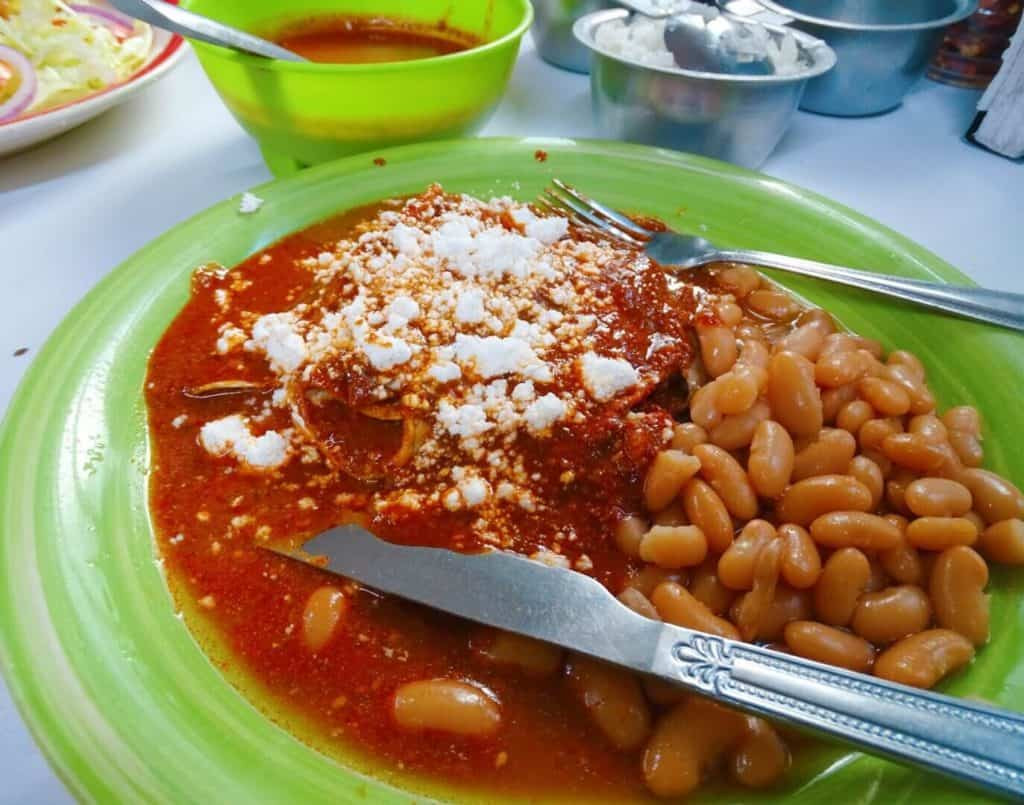 A plate of enchiladas, showcasing the saucy and cheesy goodness.
A plate of enchiladas, showcasing the saucy and cheesy goodness.
5.2. Key Ingredients: The Building Blocks of an Enchilada
The key ingredients in an enchilada are tortillas, filling, and sauce.
- Tortillas: Corn tortillas are the most traditional, but wheat tortillas are also used in some regions.
- Filling: Options range from meat and cheese to vegetables and beans.
- Sauce: Enchilada sauce can be made from chiles, tomatoes, spices, and broth.
5.3. Popular Enchilada Varieties: A Culinary Spectrum
With so many fillings and sauces to choose from, there’s an enchilada for every palate. Here are some of the most popular varieties:
- Cheese Enchiladas: Filled with cheese and covered in red or green sauce.
- Chicken Enchiladas: Filled with shredded chicken and covered in mole or sour cream sauce.
- Beef Enchiladas: Filled with ground beef and covered in chili sauce.
- Vegetarian Enchiladas: Options include cheese, beans, vegetables, and squash.
5.4. How Enchiladas Are Made: A Culinary Symphony
Making enchiladas is a relatively simple process, but it requires attention to detail and quality ingredients.
- Preparing the Filling: The filling is cooked separately and seasoned to perfection.
- Rolling the Enchiladas: The filling is placed in the tortilla, and the tortilla is rolled up and placed in a baking dish.
- Adding the Sauce: The enchiladas are covered in sauce and baked or fried until heated through.
5.5. Where to Find Enchiladas: An Enchilada Hunt
Enchiladas are sold at restaurants throughout Mexico. Here are some of the best places to find them:
- Traditional Restaurants: Look for restaurants that specialize in traditional Mexican cuisine, offering a variety of enchilada dishes.
- Street Food Stalls: Some street food stalls sell enchiladas, often in a limited range of flavors.
- Markets: Many markets have stalls selling freshly made enchiladas, often in a variety of flavors.
6. Other Popular Mexican Dishes to Explore
Beyond tacos, mole, tamales and enchiladas, Mexican cuisine is incredibly diverse. Be sure to explore other popular dishes such as:
- Chilaquiles: A breakfast dish of fried tortilla chips simmered in salsa and topped with cheese, cream, and eggs.
- Pozole: A hearty soup made with hominy, meat, and chiles, often served with toppings like cabbage, radishes, and lime.
- Tostadas: Crispy tortillas topped with beans, meat, cheese, lettuce, and salsa.
- Sopes: Thick, handmade tortillas topped with beans, meat, cheese, and salsa.
- Gorditas: Thick, stuffed tortillas filled with meat, cheese, or vegetables.
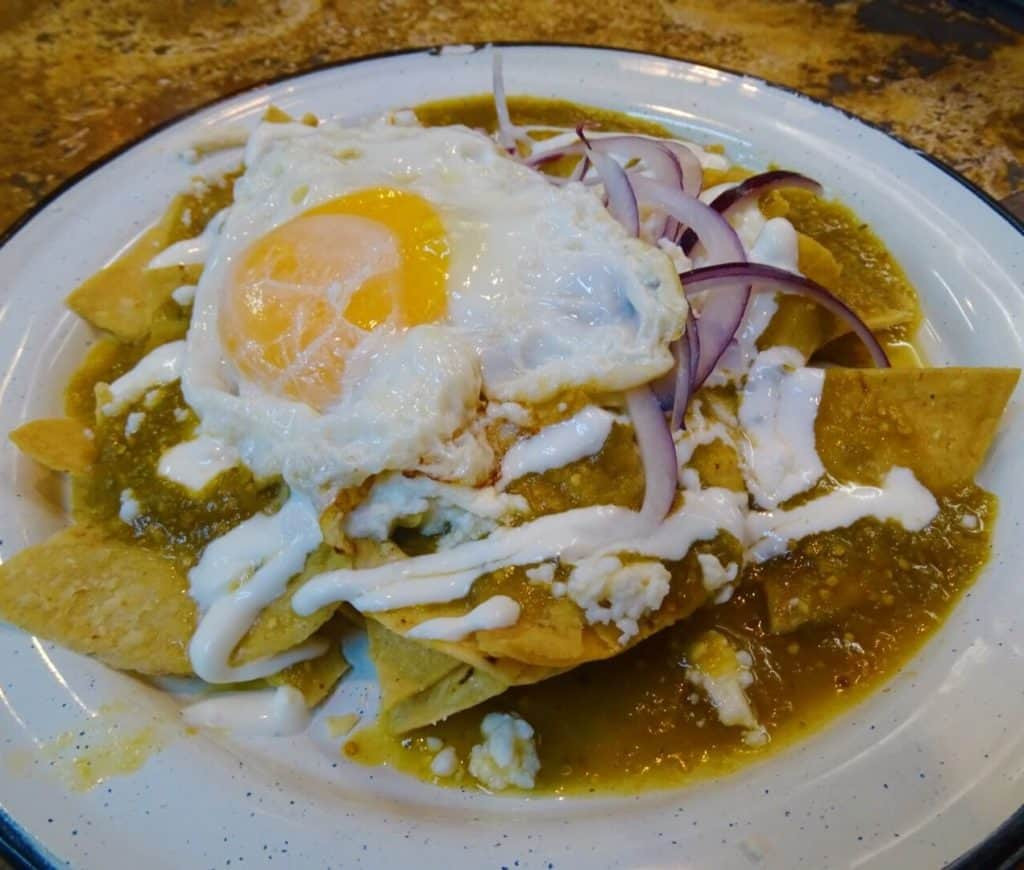 A delicious plate of chilaquiles, a popular Mexican breakfast dish.
A delicious plate of chilaquiles, a popular Mexican breakfast dish.
7. Mexican Drinks: A Refreshing Complement to Your Meal
No Mexican meal is complete without a refreshing beverage. Here are some popular Mexican drinks to try:
- Agua Frescas: Refreshing fruit-flavored waters, such as agua de Jamaica (hibiscus), agua de horchata (rice milk), and agua de tamarindo (tamarind).
- Horchata: A sweet and creamy rice milk drink flavored with cinnamon and vanilla.
- Tequila: A distilled spirit made from the blue agave plant, often enjoyed neat, in margaritas, or in cocktails.
- Mezcal: A distilled spirit made from any type of agave plant, known for its smoky flavor.
- Michelada: A savory beer cocktail made with lime juice, hot sauce, and spices.
8. Gay Mexico: Celebrating LGBTQ+ Culture
Mexico is becoming more and more popular with gay travelers. This is due in part to a growing awareness and acceptance of LGBTQ+ culture.
8.1. Popular Destinations
Mexico is well known for its vibrant gay scene, offering a variety of activities and attractions for LGBTQ+ travelers. Here are some of the most popular destinations:
- Puerto Vallarta: Known as the “San Francisco of Mexico”, is a popular destination for LGBTQ+ travelers. The city has a vibrant gay scene, with numerous gay bars, clubs, and resorts.
- Mexico City: The country’s capital is a cosmopolitan city with a thriving LGBTQ+ community. The city has numerous gay-friendly hotels, restaurants, and bars, as well as several LGBTQ+ cultural centers.
- Guadalajara: The second-largest city in Mexico, is also home to a sizable LGBTQ+ community. The city has a number of gay bars and clubs, as well as several LGBTQ+ organizations.
8.2. Gay Pride Events
Mexico hosts several large Gay Pride celebrations each year.
- Mexico City Pride: One of the largest Pride celebrations in Latin America, is held in June and attracts hundreds of thousands of participants.
- Guadalajara Pride: The second-largest Pride celebration in Mexico, is held in June and attracts tens of thousands of participants.
- Puerto Vallarta Pride: A smaller Pride celebration, is held in May and attracts thousands of participants.
8.3. Gay-Friendly Activities
In addition to the gay scene, Mexico offers a variety of other activities and attractions that are of interest to LGBTQ+ travelers. Some popular options include:
- Visiting ancient Mayan ruins
- Swimming in cenotes
- Exploring colonial cities
- Relaxing on beautiful beaches
9. Tips for LGBTQ+ Travelers in Mexico
Mexico is generally a welcoming country for LGBTQ+ travelers, but it’s important to be aware of local customs and attitudes. Here are some tips for staying safe and having a great trip:
- Research your destination: Some areas of Mexico are more LGBTQ+-friendly than others.
- Be aware of public displays of affection: While public displays of affection are generally accepted in LGBTQ+-friendly areas, it’s best to be discreet in more conservative areas.
- Learn some basic Spanish phrases: Knowing some basic Spanish phrases will help you communicate with locals and navigate your way around.
- Be aware of your surroundings: As in any country, it’s important to be aware of your surroundings and take precautions to avoid becoming a victim of crime.
- Connect with the local LGBTQ+ community: There are many LGBTQ+ organizations and community centers in Mexico that can provide support and resources to travelers.
10. Frequently Asked Questions (FAQs) about Mexican Food
10.1. What is the most popular Mexican food in Mexico?
Tacos are arguably the most popular Mexican food, enjoyed throughout the country in countless variations.
10.2. What are some traditional Mexican dishes?
Traditional Mexican dishes include mole, tamales, enchiladas, pozole, and chiles en nogada.
10.3. What is the difference between Tex-Mex and authentic Mexican food?
Tex-Mex is a fusion of Mexican and American cuisines, while authentic Mexican food is based on traditional Mexican recipes and ingredients.
10.4. What is mole made of?
Mole is made from a blend of chiles, spices, nuts, seeds, and sometimes chocolate.
10.5. What are tamales?
Tamales are made with steamed corn dough (masa), stuffed inside a corn husk with other ingredients inside such as chicken, mole, salsa verde or roja. You can also get sweet tamales which are bright pink and flavoured with guava.
10.6. What is the best Mexican drink to try?
Agua frescas, horchata, tequila, and mezcal are all popular Mexican drinks to try.
10.7. Is Mexican food spicy?
Some Mexican food is spicy, but many dishes can be made mild or with the spice level adjusted to your preference.
10.8. What are some vegetarian options in Mexican cuisine?
Vegetarian options in Mexican cuisine include cheese enchiladas, bean burritos, vegetarian tacos, and vegetable-filled tamales.
10.9. What is the most popular Mexican dessert?
Churros are a popular Mexican dessert, often served with chocolate sauce or cajeta (Mexican caramel sauce).
10.10. Where can I find authentic Mexican food in Mexico?
You can find authentic Mexican food at street stands, markets, and restaurants throughout Mexico.
Conclusion: Embark on a Culinary Adventure in Mexico
Mexican cuisine is a vibrant and diverse tapestry of flavors, textures, and aromas, offering something for every palate. Whether you’re a seasoned foodie or a curious traveler, exploring the culinary landscape of Mexico is an unforgettable experience. So, pack your bags, grab your appetite, and get ready to discover the most popular Mexican food and create memories that will last a lifetime.
Ready to explore the vibrant culinary scene and LGBTQ+ hotspots of Mexico? Visit gaymexico.net for detailed travel guides, insider tips, and the latest information on gay-friendly destinations, events, and accommodations. Connect with the community, discover hidden gems, and plan your ultimate Mexican adventure today! Address: 3255 Wilshire Blvd, Los Angeles, CA 90010, United States. Phone: +1 (213) 380-2177. Website: gaymexico.net.
